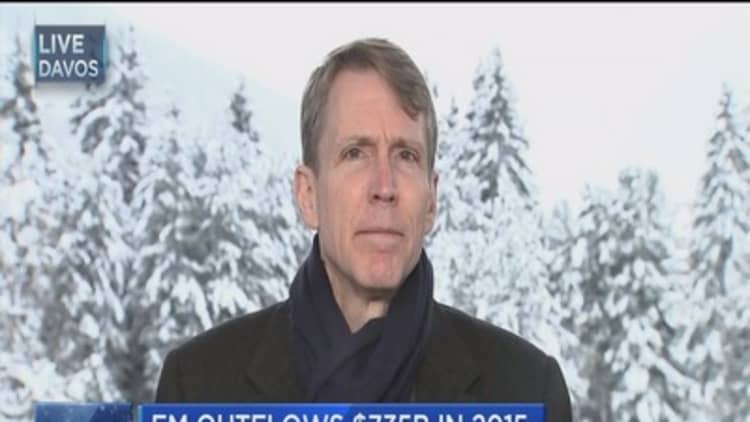
Net outflows from emerging markets (EM) weren't just bigger than expected last year, there's more pain to come this year, the Institute of International Finance said.
Emerging markets faced a whopping net $735 billion in capital outflows in 2015, including unrecorded flows from net errors and admissions, the IIF, a global financial industry association said Wednesday. In October, the IIF had projected $540 billion in net outflows, the first net negative figure since 1988, although that forecast didn't include unrecorded flows.
This year isn't likely to be much better, IIF said, forecasting total net capital outflows of $448 billion including net errors and omissions.
The finger is pointed squarely at China, although some of the outflows may have been from mainland corporates trying to be prudent.
"While most emerging markets have been under pressure, the dominant driver behind this sea-change in emerging market capital flows has been flows to China," the IIF said, citing "retrenchment" of $110 billion of non-resident capital.
"The 2015 outflows largely reflected efforts by Chinese corporates to reduce dollar exposure after years of heavy dollar borrowing, as expectations of persistent renminbi appreciation were replaced by rising concerns about a weakening currency," it said.
"China also experienced rising resident capital outflows, as domestic investors sought to move money overseas, and so did other major emerging markets, including Korea, Russia, and South Africa," IIF said.
Emerging market assets have certainly been unloved by investors: about $74 billion flowed out of global emerging market equity funds in 2015, up from $25 billion in outflows in 2014, according to data from JPMorgan. Asian emerging markets bore the brunt of the exit; $39 billion flowed out of Asia ex-Japan equity funds last year, the data showed.
That's left emerging market assets trading at low valuations, the IIF said, but it noted that it isn't clear if that's "dirt cheap" or a "new normal."
"EM corporate spreads are at their widest since 2009, while EM equities are trading at a 30 percent discount to developed markets on a forward price-to-earnings basis, and at a remarkable 65 percent discount on a cyclically-adjusted basis," the IIF said.
"Although we expect 2016 to be another year of moderate EM growth—with continued risks from China and commodities prices—some recovery in EM flows and asset prices is possible if downside risks ease and investors start to price in better prospects for 2017. However, poor fundamentals will subject markets to continued high volatility," it said.
The IIF noted another risk to flows into emerging market assets: sovereign wealth funds (SWFs).
"The sharp drop in oil prices since mid-2014 has prompted many sovereign wealth funds (SWFs) to adjust their portfolio investment strategies," the IIF noted, estimating that SWFs increased their emerging market exposure by only around $30 billion in 2015, the smallest amount since 2010.
Overall, SWFs' assets under management contracted for the first time in more than a decade, falling by over $30 billion to $7.2 trillion last year, the IIF said, noting the decline was particularly pronounced in oil-dependent Saudi Arabia, Norway and Russia.
"Our estimates show that SWFs funded by commodity export revenues reduced the size of their emerging market portfolios by over 8 percent in 2015 to $556 billion— although this was partly offset by the non-commodity funded SWFs, which increased their emerging market exposures by around $77 billion in 2015," it said.
—By CNBC.Com's Leslie Shaffer; Follow her on Twitter @LeslieShaffer1




